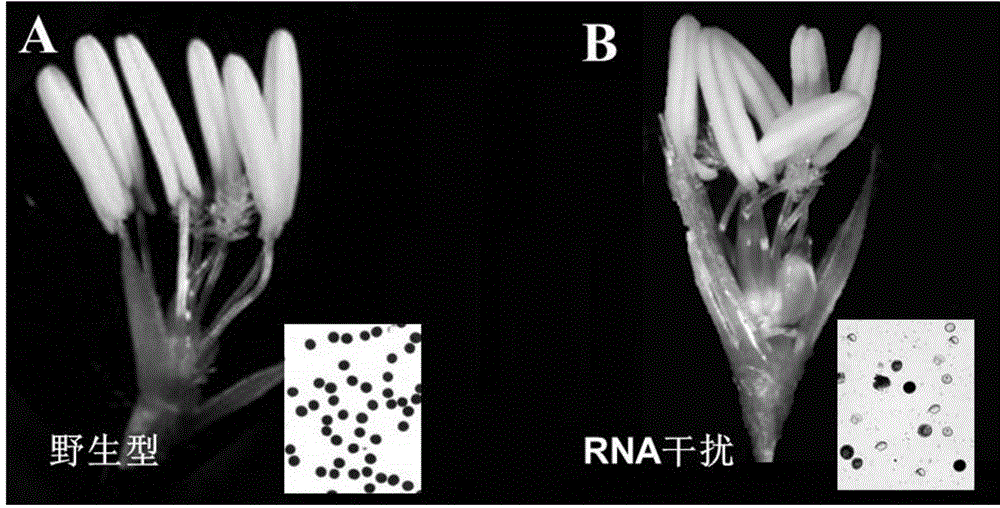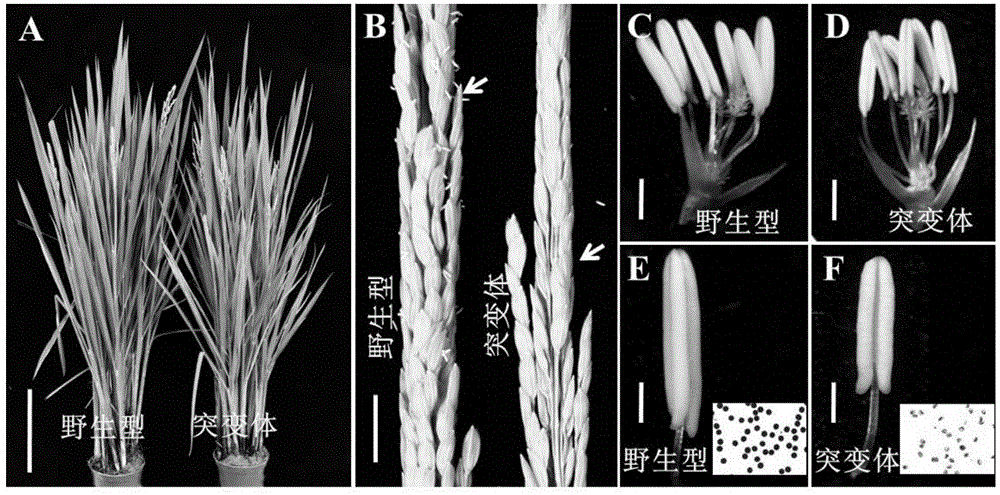Application of male sterility gene OsLAP5 and method for recovering rice male sterility
A male sterility gene and male sterility technology, applied in the fields of application, horticultural methods, genetic engineering, etc., can solve the difficulty of screening excellent combinations, the complex performance of three-line hybrid rice seeds, the limitation of the relationship between the restorer line and the maintainer line, etc. question
- Summary
- Abstract
- Description
- Claims
- Application Information
AI Technical Summary
Problems solved by technology
Method used
Image
Examples
Embodiment 1
[0041] Embodiment 1, the method for the creation of rice male sterile lines
[0042] 1.1 Create oslap5 rice male sterile lines by genetic engineering or other means
[0043] The sequence of the coding region of the OsLAP5 gene in this example is shown in SEQ ID NO.2. The osalp5 mutant material in this example was obtained from the conventional japonica rice variety Wuyujing No. 7 (also known as 9522) through RNA interference or sequence variation of the OsLAP5 gene.
[0044] 1.2 Cloning of rice fertility control protein gene
[0045] Utilize the population of rice gene location cloning (map-based cloning or position cloning) that comprises the fertility control protein gene OsLAP5 and its mutant gene oslap5 that the inventor constructed, and is clear to those skilled in the art. Within the genome fragment, for example, within 100Kb. On this basis, a genomic DNA clone containing the fragment was isolated by a conventional method. Sequencing and further hybridization identif...
Embodiment 2
[0067] Example 2 The use of oslap5 mutants in rice seed production
[0068] The oslap5 mutant was used as the male parent to cross the sterile parent in the three-line or two-line cross combination to obtain the F1 generation. In the F2 generation, a plant with both male sterility and sterility characteristics was screened, and the plant was crossed with the maintainer line corresponding to the original sterile parent. In the F2 generation, the plants with both male sterility and sterility characteristics were screened again and crossed with the maintainer line. After multiple generations of cross screening, a new male sterile line was obtained, which was suitable as the female parent in the hybrid combination.
Embodiment 3
[0069] Embodiment 3 restores the method for the male sterility character of oslap5 mutant
[0070] Transferring the genomic nucleotide sequence encoding the OsLAP5 gene into the mutant oslap5 plant can restore the mutant to the wild-type phenotype.
[0071] Primers used from rice Nipponbare BAC clone (OSJNba29L07):
[0072] OsMS16hb-F:5'AATCTAGAGGTAGGCACAAGGATGGCAA 3'(XbaI)SEQ ID NO.11 and
[0073] OsMS16hb-R:5'AAGGTAACCGTTGAACTTTGTTTGTGGAGTGA3'(BstEII) SEQ ID NO.12
[0074] A 3575bp (SEQ ID NO.1) genome sequence fragment of the OsLAP5 gene was amplified.
[0075] The fragment was inserted into the binary vector pCAMBIA1301 vector used for transformation of rice through XbaI and BstEII; the sequence verification was correct, and the vector was introduced into Agrobacterium tumefaciens (Agrobacterium tumefaciens) EHA105CGMCC No.4819 by electric shock to obtain OsLAP5 complementary Agrobacterium tumefaciens (Agrobacterium tumefaciens) EHA105, using genetic transformation me...
PUM
 Login to View More
Login to View More Abstract
Description
Claims
Application Information
 Login to View More
Login to View More - R&D
- Intellectual Property
- Life Sciences
- Materials
- Tech Scout
- Unparalleled Data Quality
- Higher Quality Content
- 60% Fewer Hallucinations
Browse by: Latest US Patents, China's latest patents, Technical Efficacy Thesaurus, Application Domain, Technology Topic, Popular Technical Reports.
© 2025 PatSnap. All rights reserved.Legal|Privacy policy|Modern Slavery Act Transparency Statement|Sitemap|About US| Contact US: help@patsnap.com



